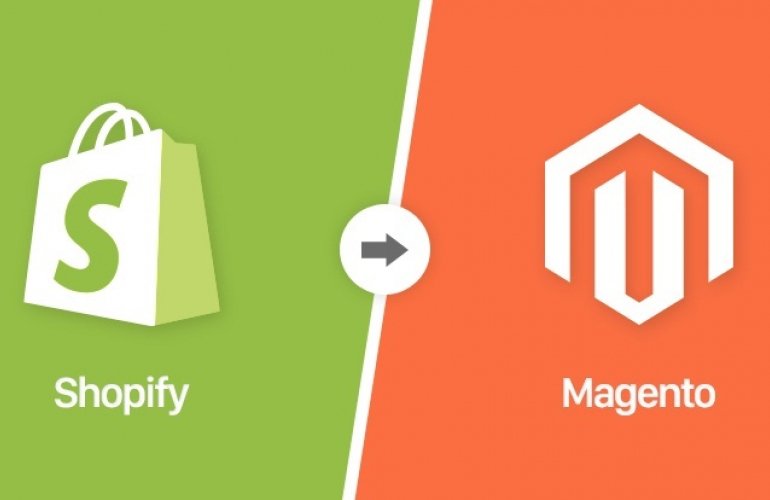How to migrate Shopify to Magento 2

Shopify and Magento are two of the most well-rounded and popular eCommerce platforms on the market today, with the former excelling in the middle ground and the latter being the smart choice at the enterprise level. As your business grows, your platform needs can change. The answer might be to migrate your Shopify store to the more powerful option.
If you’re currently using Shopify and you’re reaching the upper limits of what you can achieve with it, it might be time to step up to the possibilities and power of Magento.
Manual or Automatic Migration?
It’s possible to migrate from Shopify to Magento using an automation tool, but it won’t be ideal in every circumstance.
If your Shopify store data is immensely complex, then it may be necessary to deal with it manually (to avoid any costly errors) — conversely, if it’s very thin, then there may be no practical benefit to using a tool.
How to Perform a Manual Migration
To manually move your data across from Shopify to Magento, you’ll need to first export everything you need from Shopify.
For your products, orders, and customers, you can export the data to standard CSV files using native options, but there’s a 9000 row limit for each file — if you any set of data exceeds 9000 rows, you won’t be able to manually export them that way (you’ll need to use an app from the Shopify app store).
If nothing exceeds 9000 rows, then you can export everything to common files ready to be imported into your Magento installation. You won’t be able to export any themes, but you can redownload any images you provided if you didn’t keep the original versions.
From here, you need only go into your Magento admin dashboard, then proceed to System, Import/Export, and Dataflow Profiles. You can then import your products, customers, and orders by selecting the CSV files you created.
Keep in mind that this will have limits, however — because CSV files are very basic, you won’t get a very comprehensive import. For that, you’d need an automation tool.
How to Automate Your Migration
Often, it’s simplest and easiest to use a migration tool to connect your new Magento store to your old Shopify store and pull the data across that way. There are two such tools I’d suggest considering:
- Migrate from Shopify – This Magento marketplace extension can be purchased for $99 and used to migrate data from a Shopify store to a Magento Community store. Though it doesn’t seem to be compatible with Magento 2, so it’s only going to be useful to you if you already have a Magento 1 store or you’re avoiding Magento 2 for whatever reason.
- Cart2Cart – This service fully supports every version of Magento and will hook into both your Shopify store and your Magento store to move over all the data you want. The starting price is $69, but it will depend on how much data you have to transfer, as well as any optional extras you want (such as configuring 301 redirects).
Since a new Magento store should run on Magento 2, Cart2Cart is really the best option for this approach. The cost might add up if you want all the optional extras, but there’s every chance that the total will still be far less than you’d spend on dealing with the inconvenience of getting it sorted manually. There is one option we’ve yet to look at, though, so we’ll get to it next.
Get a Specialist To Do It Instead
If you don’t want to deal with the migration manually but you also don’t want to use an automated app or service to handle your precious data, you can entrust a Magento specialist with the task.
A true eCommerce specialist will be able to take a closer look at your exact requirements, give you a much more targeted quote, and keep you apprised of everything that’s happening (and any issues that appear during the process).
Given the awkwardness of moving from one system to another, this may be the most sensible way to proceed, because you can keep them as a consultant to help you learn the ropes of Magento and deal with the things you couldn’t migrate (such as aesthetics).
The last thing you want to do is finish your move to Magento only to struggle with the admin tools for months and fail to benefit from the new platform.
You can also leverage the association to keep your marketing neat. Overhauling your store is a big step for your customers as well, and will likely cause some confusion at first.
Having crystal-clear redirects, optimizing your homepage, and using an email blast to notify your existing customer base will be vital for retaining as much customer loyalty as possible.
Are you running out of time and skill to perform the migration on your own?
Migrating from one platform to another platform is not at all an easy process until you have tech knowledge. To carry out the migration process smoothly, you need to reply on Magento expert. We at Monsoon Consulting have trained 37 Magento 2.0 developers who will perform data migration for you, providing all the required customization and support on each step of your migration process.




